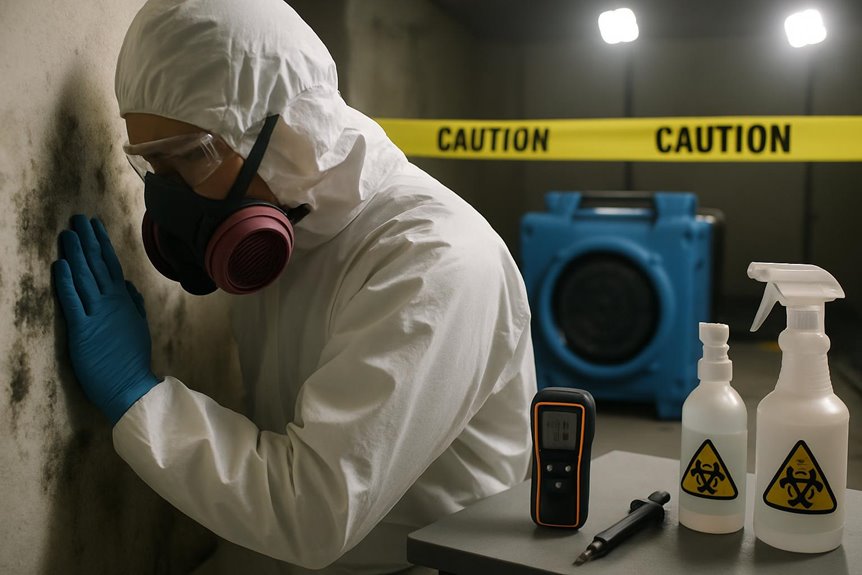Mold contamination poses significant health risks, especially in the presence of biohazards. Addressing this issue requires a systematic approach to guarantee safety and effectiveness. The first vital step involves evaluating and identifying the type of mold present. Following this, containment of the affected area is essential to prevent further spread. Lastly, the safe removal and disposal of contaminated materials must be conducted with caution. Understanding these steps can make a significant difference in managing mold emergencies effectively.
Key Takeaways
- Conduct a thorough assessment to identify the type and extent of mold contamination, focusing on health risks associated with different mold species.
- Immediately contain the affected area by sealing it off with plastic sheeting and using negative air pressure machines to prevent spore spread.
- Equip all personnel with appropriate protective gear, including gloves, masks, and goggles, to ensure safety during remediation efforts.
- Safely remove and dispose of contaminated materials in sealed plastic bags, following proper protocols for hazardous waste disposal.
- Implement effective mold testing methods to guide remediation strategies and monitor airborne mold concentrations throughout the process.
Assess and Identify the Mold Contamination
A thorough assessment and identification of mold contamination are critical first steps in effective mold remediation. Various mold types, such as black mold, Aspergillus, and Penicillium, can be present in affected areas, each posing distinct health risks. Symptoms may range from mild respiratory issues to severe allergic reactions or toxic effects, making it essential to identify the specific species involved. Professionals typically use visual inspections, moisture meters, and air sampling techniques to assess contamination levels accurately. Understanding the extent of the contamination allows for tailored remediation strategies, ensuring a safer environment for occupants. By prioritizing assessment and identification, individuals can reclaim their spaces while safeguarding their health and well-being from the potential dangers of mold exposure. Additionally, effective strategies such as containment and removal are vital for preventing further spread during the remediation process. Implementing proper mold testing methods can significantly enhance the assessment process by providing precise information on mold species present and their concentrations.
Contain the Affected Area
Effective mold remediation requires immediate steps to contain the affected area, preventing the spread of spores to other parts of the environment.
Implementing effective containment strategies is vital for minimizing exposure during the remediation process. Isolation techniques should be employed to seal off the contaminated space, using plastic sheeting and tape to create barriers. This helps to prevent spores from migrating to clean areas. Additionally, mold spores can remain dormant and be disturbed, leading to further contamination.
Furthermore, the use of negative air pressure machines can further enhance containment by filtering air and reducing airborne mold particles. Black mold remediation is best conducted by trained professionals to ensure thorough and safe removal.
It is essential to guarantee that all personnel wear appropriate protective gear when working in the isolated area. By taking these proactive measures, the risk of cross-contamination is markedly reduced, promoting a safer environment for all.
Safely Remove and Dispose of Mold-Infested Materials
Removing and disposing of mold-infested materials is a critical step in the remediation process. This guarantees the safety of the environment and the individuals involved. Employing effective mold removal techniques is essential, especially when dealing with hazardous materials. The following steps guide this process:
- Wear protective gear, including gloves, masks, and goggles.
- Seal contaminated materials in plastic bags to prevent spore spread.
- Use appropriate tools for removal, avoiding damage to surrounding structures.
- Dispose of materials at designated hazardous waste facilities.
- Clean the area thoroughly to eliminate any remaining mold spores.
Moreover, understanding the difference between DIY and professional mold removal methods can help you make informed decisions on how to proceed effectively. Always follow industry best practices for mold remediation to ensure thorough and safe removal.
Frequently Asked Questions
To prevent mold growth after remediation, maintaining moisture control and improving ventilation are essential. Regular monitoring of humidity levels and ensuring adequate airflow can greatly reduce the risk of future mold development in affected areas.
What Personal Protective Equipment Should I Use During Mold Removal?
During mold removal, proper safety gear is essential. Individuals should wear protective clothing, including masks, gloves, and goggles, to minimize exposure to spores and harmful substances, ensuring a safer and more effective remediation process.
Are Certain Types of Mold More Dangerous Than Others?
Certain mold types, particularly toxic mold, pose significant health risks, including respiratory issues and allergic reactions. Understanding these variations is essential for effective management and ensuring safety during mold remediation efforts in affected environments.
How Can I Tell if Mold Is Hidden Behind Walls?
Determining hidden mold behind walls often involves a thorough wall inspection. Signs include water stains, musty odors, and visible discoloration. Professional assessments can effectively identify and address concealed mold issues, ensuring a safer living environment.
Should I Hire Professionals or Can I Do It Myself?
When deciding between DIY mold removal and professional services, one should consider the severity of the infestation. Professionals offer expertise and safety, while DIY may suit smaller issues, providing a sense of autonomy for homeowners.
Conclusion
To conclude, effectively addressing mold contamination due to biohazards requires a systematic approach. By first evaluating and identifying the mold type, professionals can gauge potential health risks. Next, implementing containment measures is essential to prevent further spread of spores. Finally, the safe removal and disposal of contaminated materials guarantees a thorough remediation process. Adhering to these steps not only protects health but also contributes to restoring a safe environment.

